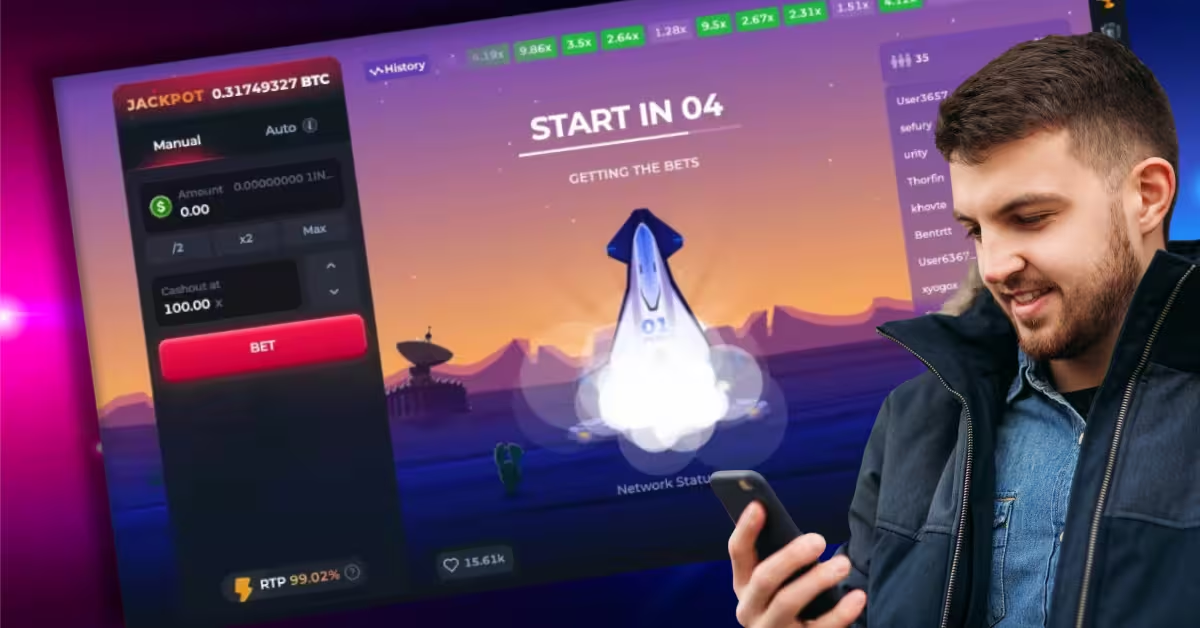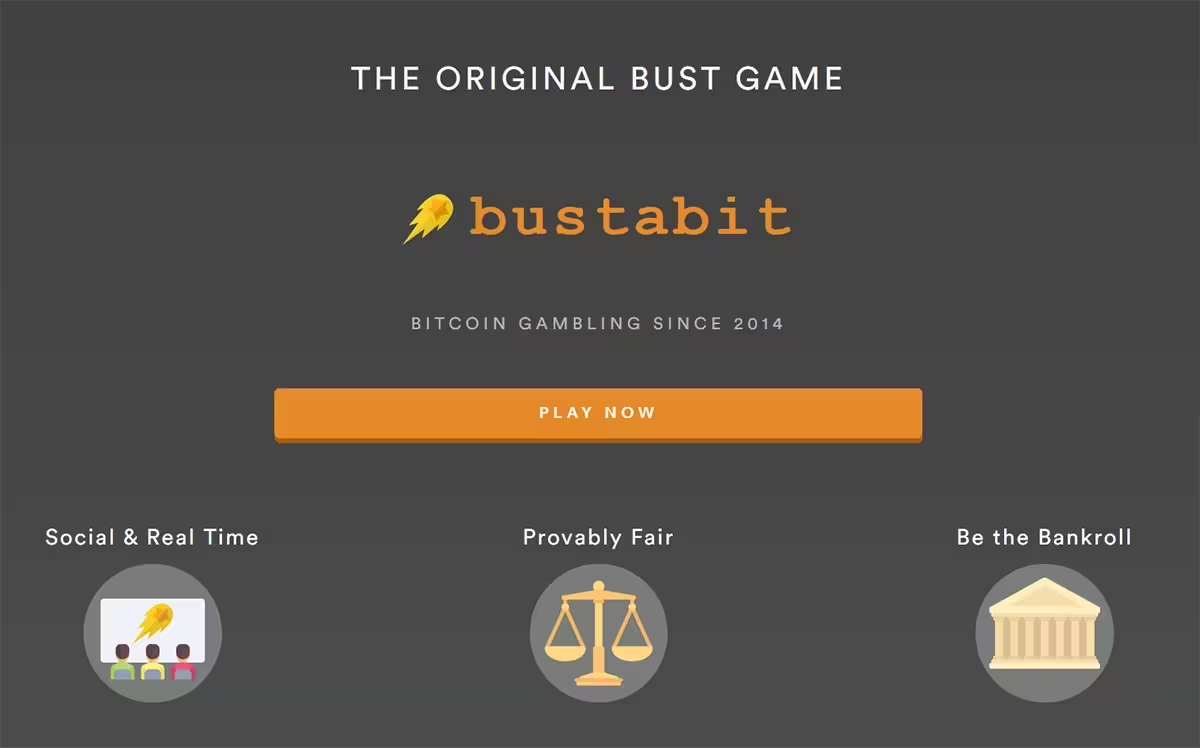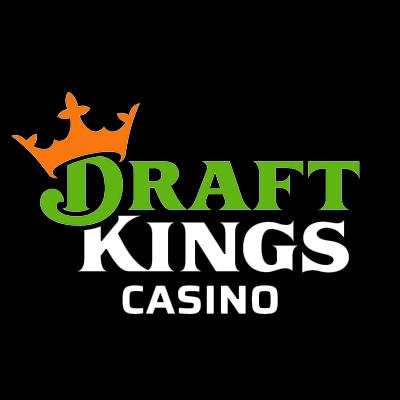What Are Crash Games? The New Gambling Trend on Mobile

Most of our attention spans are almost nonexistent (I said most, not all, so don’t get mad if you don’t have ADHD), dopamine is currency, and instant gratification always wins. A lot of us can’t sit through a full poker hand without checking our texts, Googling something random, and scrolling TikTok at the same time.
And that’s why crash games are everywhere and getting more popular by the minute. They’re stripped-down, super twitchy, and are designed to reward quick fingers and impulsive decisions.
We need to get one thing straight: there are NOT your standard casino games. Crash games strip gambling down to its bare bones, and that’s risk vs. timing. Every second that ticks by ramps up the possible payout and the anxiety. And it’s why they’re so popular with mobile users; they’re simple, speedy, and have an addictively interactive feel.
If you’ve not heard of them and are curious about what they are, how they work, and what mobile players should know, we’ll explain it all!
What Are Crash Games?
As we said above, crash games strip gambling down to two things: timing and nerve. A multiplier climbs. It crashes. You have one job, and that’s to get out before it does. The concept seems more like a shot of adrenaline mixed with a panic attack than a casino game, and that could explain why mobile users love them.
Crash games don’t hide anything behind symbols or odds tables. What you see is what you get: a fast-moving line, a growing payout, and the ever-present danger that one second too long will wipe it all out.
Basic Concept
Every round starts out the same way: the multiplier begins at 1.00x and climbs. You place your bet before the round begins, then watch the multiplier rise; sometimes it moves slowly, and sometimes alarmingly fast. At any point, you can hit “cash out” and lock in the current multiplier. But once the game crashes? The round is over. And anyone who hasn’t cashed out loses their whole wager.
The crash point is random but predetermined using a provably fair algorithm. That means you can’t predict it, but it’s not manipulated mid-round. It could stop at 1.06x or spike past 100x before cutting off. That unpredictability is the heart of the game’s tension: the longer you stay in, the bigger your reward, but the risk grows with every tick.
Some platforms do offer auto-cashout tools, and that gives players a preset exit point. That adds a bit of strategy for players who use betting systems or try to manage losses across multiple rounds. But ultimately, it’s all about timing: quick reactions and knowing when to pull out.
Visual & Gameplay Style
The interface is usually centered around a live graph with a curved line going upward, and a plane, rocket, or dot climbing along it. Below or beside it, you’ll see a running list of player names, their bet amounts, when they cashed out (or didn’t), and what their return was. The list of other players? That’s not just for show; it’s part of the insane pressure. You can see all the other players who are bailing or trying to hang on for dear life.
The basic layout is purposeful, as it eliminates all unnecessary distractions. It’s designed to load super fast and run on mobile, with basic animations. And it’s what makes crash games ideal for phones; they’re low-lag, low-hardware, and take only a tap or two to play. The whole experience is built for quick bets and short rounds, which makes it easy to play casually or compulsively.
Some games add small design flourishes, like animated explosions or themed backgrounds (planes crashing, meteors falling, etc.), but the core is unchanged. Every round plays out on the same graph, and the action is centered on that rising multiplier.
Origins

Crash games started gaining traction in the crypto gambling space around 2014. The first major title to use this format was Bustabit, which became popular for its simplicity and its use of provably fair code. That means each crash result is generated using a cryptographic hash that can be verified by players after the round, which removes any doubt that the house is interfering with outcomes.
The level of transparency helped crash games gain a following among crypto users, who were already used to volatility and high-risk trades. The gameplay felt really familiar: just like watching a token price rise and trying to decide when to sell before a market drop.
Other early platforms like Crashino, BC.Game, and Stake adapted the concept and added their own visual styles or bonus features. But the structure hasn’t changed much. Even now, crash games stick to the original formula: simple rounds, fast pacing, and public results.
As crypto gambling grew, mainstream mobile casinos started to catch on. Today, you’ll find crash games outside the crypto bubble, as they’re offered on regular real-money gambling apps with fiat currencies. The basic appeal hasn’t changed; it’s still risk vs. reward in the most direct form possible.
How Crash Games Work
Crash games follow the same format every single round. What does change is the pace, the outcome, and the way you respond! Below is how they work:
Step-by-Step Gameplay
- Place your bet: You enter your wager during a short countdown between rounds. Most platforms give you the option to set an auto-cashout target before it starts.
- Watch the multiplier rise: The round starts, and the multiplier begins to increase. There’s no set speed; it could climb gradually or accelerate quickly. Every second that you stay in, your possible payout increases.
- Cash out before the crash: You can exit at any point. If you hit cash out before the game ends, you win the amount that’s shown. If the multiplier crashes before you exit, your entire bet is gone. There are no second chances.
- Get ready for the next round: The game resets within seconds. New bets come in, and the cycle repeats. There’s only a brief pause between rounds.
All rounds are quick (usually under 10 seconds), and players tend to play one round after another without much downtime.
Main Game Features
Crash games are built to remove anything that slows players down. Most include the following features:
- A real-time graph that shows the multiplier increasing throughout each round.
- Live player results showing when others cashed out and what they won (or lost).
- Simple controls with one or two buttons (cash out and auto-cashout) and they’re displayed on-screen for quick taps.
The design focuses entirely on decision speed and clear outcomes.
Multipliers and Randomness
All rounds end at a random crash point, and that multiplier is generated before the round begins using one of the two following systems:
- Random number generators (RNGs): These are used on all licensed casino apps. The RNG determines the crash point using certified algorithms that are tested for fairness.
- Provably fair systems: Found on crypto gambling sites, these use hashed values from player and server inputs to set the multiplier. You can verify the result after each round to confirm that it wasn’t changed.
There’s no pattern, no momentum, and no way to predict when the round will end. The crash point is locked before the multiplier even starts. Every single decision is made with incomplete info, and that’s the whole shebang.
Why Crash Games Are So Popular on Mobile
Crash games clicked for mobile because they match up with how people already use their phones. Short sessions, quick taps, no patience required.
- Instant Gratification – You don’t have to wait around. There’s no slow buildup or drawn-out finish. Once the round starts, it’s over almost as quickly. You win, or you don’t, and you move on. That kind of pace is exactly what mobile gambling leans into: quick results, fast reload, and no delay between decisions.
- Minimalist Design – The layout is stripped back on purpose. No menus, no side features, no animation that drags out the round. It works on older phones, weak connections, and in whatever random place you’re playing from. You can bet and cash out with one thumb while half-paying attention to something else.
That simplicity makes it feel accessible, even for players who don’t usually go near traditional casino games. - High Risk, High Reward Appeal – Every round asks you to make one call. There’s nothing to learn, and the outcome feels tied to your choice. That’s the hook! You could cash out early and take a small win. Or you could hold and try to double it.
It doesn’t feel like it’s random, even though it is. And that’s why players keep coming back. - Social Component – Yes, you’re playing solo, but the results feed reminds you that you’re not the only one making the call. You can see who bailed early and who pushed it too far. It doesn’t have to be social to be super competitive.
- Crypto and Esports Influence – Crash games started on crypto platforms, where users were already staring at graphs and watching numbers spike. The gameplay copied that feeling and turned it into something faster.
Once it moved to mobile, the format hit its stride. No long sessions, no list of rules, just a rising number and a single choice. That’s all it needed.
Best Crash Game Apps for Mobile
A lot of online casinos have crash games in their mobile apps! Let’s find out which are the best ones and where you can play them.
Top Mobile Casino Apps Offering Crash Games

DraftKings Casino (iOS & Android): A leading U.S. sportsbook/casino app that has the exclusive DraftKings Rocket game. Rocket (and its sequel, Rocket 2) is a crash-style game developed in-house by DraftKings, and it’s available in all states where DK Casino operates (NJ, PA, WV, MI, CT). The game supports group play, and you see other players on the rocket and when each cashes out.

FanDuel Casino (iOS & Android): FanDuel, another major U.S. operator, recently introduced Take-Off! (its own crash game) as an app-exclusive title following DraftKings’ lead. Take-Off! offers the same high-risk, high-reward gameplay within a regulated platform. FanDuel’s app runs on both iOS and Android, and the crash game is available in states where FanDuel Casino is live (NJ, PA, MI, WV, and CT).

BetMGM Casino (iOS & Android): A top-tier casino app that has begun adding crash games in some markets. BetMGM Ontario and BetMGM UK offer Spribe’s Aviator (the popular plane-themed crash game) and Pragmatic Play’s Spaceman crash game. These games are found under BetMGM’s “arcade” or specialty games section. Spaceman is a cartoon-style crash game with easy one-tap gameplay. Note: As of now, BetMGM’s crash games are available in certain regions like Canada/Ontario; U.S. state apps might introduce them as the trend grows.
Bonus Offers & Free Spins
A perk of playing on reputable casino apps is the welcome bonuses available, and crash game fans can often take advantage of these offers. All mainstream casino apps give new players deposit match bonuses, free spins, or no-deposit rewards that can be used to try out games (including crash titles). Below are some highlights:

DraftKings Casino: New users get a 100% deposit match up to a certain amount (often up to $2,000) plus additional credits. The credits can be used on any casino game, so you could put them toward Rocket rounds. Standard 15x wagering requirements apply to DK’s bonus, so keep that in mind.

FanDuel Casino: FanDuel has run promotions like “Deposit $10, get $40 bonus plus 500 free spins” for new players. The free spins are usually for slots, but the bonus funds could be used on crash games. FanDuel’s low wagering requirement (1x on some offers) makes it very attractive, and you can test out crash games with minimal risk.
Ease of Use & Design
A well-designed app guarantees that placing bets and cashing out at the right moment is quick and foolproof!
The best casino apps prioritize clean layouts and responsive controls for crash games. The cash-out button and bet controls in crash games are prominently displayed and react instantly to your tap, whether you’re on a tablet or a mid-range smartphone.
Mobile optimization is super important. A crash game should be adapted cleanly to small screens with no freezing, no overlapping UI elements, and work on older devices. Well-built apps also support features like notifications or sounds that alert you when a round is starting, which is always helpful if you’re multitasking on your phone.
In terms of visual design, crash games themselves are always minimalistic: a graph or animation of a rising object, plus some stats and buttons, and that’s about it!
Strategies for Playing Crash Games
Crash games are luck-based, but there are players who use a few strategies to manage risk and reward. The whole allure of crash is that you control when to cash out, but there is no strategy that can overcome the house edge (usually ~3% in crash games); any of these tactics only influence short-term results and your personal risk tolerance.
Common Player Tactics
When playing crash games, people generally fall into one of two camps: those who cash out at low multipliers regularly, and those who chase high multipliers for a big win. Both have pros and cons, and most experienced players mix strategies depending on how the game is going.
- Conservative “auto cash-out” strategy: A really common tactic is setting an auto cash-out at a relatively low multiplier every round, like 1.3x or 1.5x. This locks in small, almost steady wins as long as the game doesn’t crash extremely early. The idea is that crashes below, say, 1.3x are relatively rare, so you win most rounds, albeit winning small amounts. This approach limits big losses but also means you’ll never hit the huge multipliers when they happen.
- Aggressive “high multiplier” strategy: Other players prefer to cash out manually and hold on for a big score. They might aim for 5×, 10×, or higher; occasionally, someone even tries to ride it to 50× or more. This is high-risk, high-reward. You’ll usually bust (because the object crashes before reaching your lofty target), but when you succeed, the payout is huge.
- Balanced or hybrid approaches: Some crash veterans use a hybrid tactic and place two bets: one cashes out very low (guaranteeing a small profit to cover the round), and the second one they let ride higher for a chance at a big profit. The safe bet can offset the risky bet’s loss most of the time.
Bankroll Management
Decide ahead of time how much money you’re willing to risk in a crash session, and stick to it. Treat that amount as the cost of entertainment. Once you hit either the loss limit or the win goal, stop playing! This prevents chasing losses or getting overconfident and dumping winnings back in.
Because crash rounds are high-variance, a common guideline is to wager only a small percentage of your total bankroll per round (say 1-5%). If you have a $100 bankroll, betting $1 or $2 per round is reasonable. Some players use a flat betting scheme (same bet every time) to avoid the temptation of increasing bets after losses.
It’s human to feel like upping your bet to win back what you lost, but you have to resist that urge. Chasing losses is a dangerous spiral, especially in a game that can crash multiple times sequentially.

All crash games let you set auto-bet and auto cash-out. If you find yourself second-guessing or impulsively changing bet sizes, consider using these features with predetermined settings. Just be sure to monitor and stop the auto-play if you reach a limit. Some games also have a built-in stop on win/loss feature where you can tell it to stop auto-betting after you’ve lost a certain amount, so make use of that if it’s available!
Psychology of Timing
The psychological aspect of crash games is perhaps the most challenging part to master. The games toy with two powerful emotions: greed (the fear of missing out on an even higher multiplier) and fear (the anxiety that the crash could happen any second).
First off, it’s important to debunk the idea that you can predict or “time” the crash based on gut feeling or patterns. Every round is determined by a random number generator (or a provably fair algorithm). There is no increasing chance of a long round just because several short rounds happened before. This is the classic gambler’s fallacy, aka thinking a win is “due” after a string of losses, and it does not apply to independent events.
The crash format is an adrenaline rush, and that’s part of the fun, but it can cloud judgment. Set rules for yourself! Taking a short break after a big win or big loss is a smart move; it lets your emotions regulate.
Finally, keep the entertainment mindset. The moment you start thinking “I need to win my money back” or you’re not having fun, the psychology becomes unhealthy. Crash games put the outcome partially in your hands, and that can create an illusion of control. A good mental check is to remind yourself: You have no control over when it crashes; you only control when you exit. Concentrate on making good decisions on the part you control (exiting according to your plan), and make peace with the fact that you’ll still lose.
Risks and Responsible Gambling Tips
Crash games, by their very nature, are addictive, and the high volatility can turn into big and rapid losses if you’re not careful! You have to know the risks and how to gamble responsibly!
High Volatility = High Risk
Crash games have a high volatility profile. In simple terms? The outcomes (and your bankroll) can fluctuate crazily in a really short time. Unlike a low-variance slot where wins and losses even out more gradually, a crash game can deliver a 100× win one minute and then eat five bets in a row with near-instant crashes. That unpredictability is exciting but also perilous.
It’s important to internalize that losing streaks will happen, and they can happen without warning. You might be cruising along with 2×, 3× cash-outs, and then suddenly the next rounds crash at 1.05×, 1.10×, 1.01× back-to-back. A player on an aggressive strategy could drop a lot of money in that span.
To mitigate risk, treat a crash game like you would treat a high-volatility stock or a bet on a long shot: never wager money you can’t afford to lose. Using smaller bet sizes or limiting the number of rounds you play in one session will control how much you have “at risk” in total. It’s also smart to mentally prep yourself that you could lose everything you bet on a given session. If that thought is unbearable, you’re betting too much or playing too long.
Set Time and Money Limits
One of the smartest ways to gamble responsibly is to proactively set limits on your play. This means both time limits (how long you will play) and money limits (how much you’re willing to lose or even win). Setting these boundaries before you start playing is a must, because once you’re caught up in the excitement of crash rounds, it’s so much harder to impose discipline.
Here’s how to go about it:
- Time limits: Decide how much time you’ll devote to crash gaming in a given day or week. Maybe it’s “30 minutes per day” or “no more than 2 hours on the weekend.” Use alarms or reminders on your phone if needed, and most casino apps have reality check features that will pop up after a certain amount of play time to remind you how long you’ve been gambling. Take those seriously!
- Money limits: This includes deposit limits, loss limits, and wager limits. All reputable casinos allow you to set daily or weekly deposit caps in your account settings. Use them! If you set a $100 weekly deposit limit, even if you get tempted, the system won’t let you put in more. Some platforms let you set a loss limit as well. The key is to establish these monetary guardrails in advance.
If you feel things are getting out of hand, you have options. Every licensed casino app provides self-exclusion tools, and they can range from a short “timeout” ( 24 hours or a week where your account is locked) to a longer exclusion (several months or even permanently). There are also cool-off periods you can trigger; you can go into your account and select a 72-hour or 1-week cooling-off period, during which you can’t log in.
Recognizing Problem Gambling Signs
Knowing the warning signs of problem gambling can help you catch issues early and get help if you need it. Here are the red flags to watch out for:
- Betting more than you intended: Do you frequently deposit more money after losing, even though you told yourself you wouldn’t? If you find that every time you play crash, you spend way over your planned budget, that’s a sign of loss of control. And gambling longer than you intended to is another warning sign.
- Neglecting responsibilities or relationships: Has crash gaming (or gambling in general) caused you to skip work, school, or family obligations? Maybe you’re staying up way too late, or you’re distracted thinking about gambling when you should be focusing on other things. If gambling is intruding on important areas of life, it’s a serious concern.
- Chasing losses to “get even”: This is a hallmark of problem gambling; you lose money, get upset, and immediately want to win it back by gambling more. If you catch yourself doing this, it’s a danger sign. Healthy gambling means accepting losses; if you cannot accept a loss and you feel compelled to continue until you’re whole, that’s a problem.
- Lying or hiding gambling: Are you lying to your spouse or family about how much you gamble or losing money and not telling them? Do you try to sneak in crash game sessions and hide the evidence? Deception indicates that you’re well aware on some level that the behavior is problematic. Hiding the extent of gambling is a major red flag.
Professional Help Resources
Organizations like the National Council on Problem Gambling (NCPG) in the U.S. offer hotlines (1-800-522-4700) and text/chat services to get help. They connect you with counselors who understand gambling addiction.
Internationally, there are groups like Gamblers Anonymous (GA) and services like GamCare or Gambling Therapy (in the UK) that provide free support and counseling. All of the above organizations aren’t going to judge you; they will help you.
The Future of Crash Games in Mobile Gambling
Crash games started as crypto curiosities and are now one of the fastest-growing formats in mobile gambling. As they spread across mainstream apps, expect the gameplay to evolve—more variety, more crossover, and more oversight.
Innovation Potential
Developers are moving past just rockets and graphs. Expect crash games with new themes, like racing, finance, and sports, and social features like live chat, leaderboards, and team modes. Some may add bonus rounds, second-chance mechanics, or even AR elements to freshen up the format.
Integration into Other Game Types
Crash mechanics are already blending into slots, sports betting, and live dealer games. There could be slot bonuses with crash-style rounds, or live hosts narrating a shared multiplier game. Esports tie-ins and sportsbook mini-games aren’t too far behind.
Regulatory Considerations
As crash games go more mainstream, regulators are paying closer attention. With such fast gameplay and high volatility, expect discussions around age restrictions, play limits, and responsible gambling tools. Licensed casinos will adapt, but the offshore and unregulated casino sites? They’ll be under a ton of pressure.
Conclusion
Crash games have become one of the favorite go-tos for mobile gamblers who want to play something fast, simple, and fun. They don’t waste any time; you bet, watch the number climb, and you make one decision. That structure works really well on phones, and that’s why these games are catching on across both crypto and mainstream casino apps!
Look below for a brief refresher on all things crash games:
- Each round is super quick, with a rising multiplier and only one chance to cash out.
- The mobile design makes it easy to play anywhere, anytime.
- The gameplay is simple, but the outcomes are always unpredictable.
- Losses can add up really fast, so pacing, bankroll management, and responsible gambling are a must!
If you’re going to try crash games, go in with a plan! That means seconding on how you want to play, setting limits, and not getting pulled into chasing losses. These games are built to be addictive, so don’t let them crash you out.




